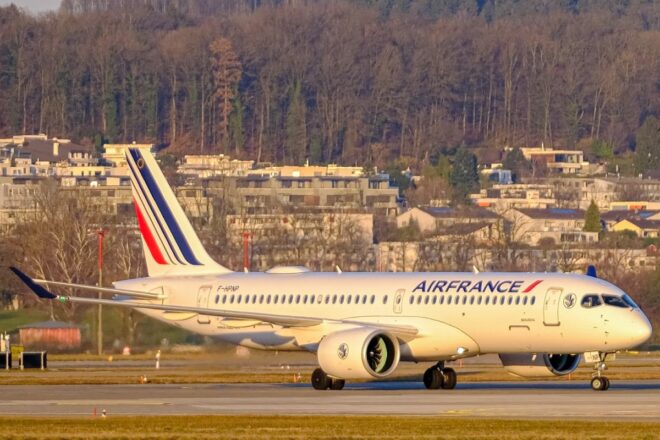
Heroic Air France Pilot Makes Emergency Landing to Save Passenger’s Life
In an extraordinary display of professionalism and compassion, an Air France pilot recently made an emergency landing to save a passenger’s life. The pilot, hailed as a hero by those on board, took swift action when a medical emergency threatened the life of one of the passengers. This incident underscores the dedication of airline crews to passenger safety and the crucial role pilots play in emergency situations.
The Mid-Air Crisis
The incident occurred on an Air France flight en route from Paris to New York. About three hours into the transatlantic journey, a middle-aged male passenger suddenly collapsed in his seat. Witnesses recalled a moment of panic as fellow passengers and flight attendants rushed to his aid.
The crew quickly assessed the situation and determined that the man was experiencing severe chest pain and difficulty breathing, symptoms indicative of a heart attack. Fortunately, an onboard doctor, who happened to be a passenger, volunteered to assist. After conducting an initial examination, the doctor recommended an immediate landing, emphasizing that the passenger required urgent medical attention that could not be provided in the air.
The Pilot’s Heroic Decision
The captain, an experienced Air France pilot with over 20 years of flying experience, was immediately notified. He consulted with both his co-pilot and ground medical experts before making the bold decision to divert the flight. Despite being over the Atlantic Ocean, the crew identified the nearest viable airport for an emergency landing: Shannon Airport in Ireland.
Pilots are extensively trained to handle a variety of emergencies, including medical crises. However, the decision to divert a flight is never taken lightly. It involves numerous logistical and operational challenges, including coordination with air traffic control, fuel calculations, and securing immediate medical assistance upon landing. The Air France captain demonstrated remarkable decisiveness and leadership in executing the diversion with precision.
A Smooth Emergency Landing
As the aircraft descended toward Shannon Airport, the cabin crew worked tirelessly to ensure the passenger remained as stable as possible. Oxygen masks and emergency medical supplies were utilized, and the onboard doctor continued monitoring the man’s condition.
Upon landing, emergency medical personnel were already waiting on the tarmac. The passenger was quickly transported to a nearby hospital, where he received the necessary medical care. Reports later confirmed that the swift intervention and immediate medical attention had likely saved his life.
Passengers Praise the Crew
Following the incident, passengers expressed immense gratitude for the pilot’s decision. Many took to social media to commend both the captain and the cabin crew for their quick thinking and professionalism.
One passenger, a business traveler who was seated near the ill man, described the pilot’s decision as “a true act of heroism.” Another passenger praised the calm demeanor of the flight attendants, noting how they managed to keep the situation under control while reassuring the other travelers.
Air France also released a statement applauding the efforts of its flight crew and reinforcing the airline’s commitment to passenger safety. “The well-being of our passengers is our top priority. We commend our crew for their swift and effective response, which ensured that medical help was provided in the shortest possible time,” the statement read.
The Complexity of In-Flight Medical Emergencies
While aviation technology and stringent safety protocols have significantly improved air travel, medical emergencies remain unpredictable. Airlines are equipped with basic emergency medical kits, and flight attendants receive first aid training, but there are limits to what can be done without access to full medical facilities.
In many cases, pilots must weigh the risks of continuing the flight versus the urgency of an emergency landing. Diversions are costly, affecting schedules and causing delays for all passengers, but in situations where a life is at stake, the decision is clear. Medical experts advise that in cases of heart attacks, strokes, or severe allergic reactions, every minute counts, making timely access to professional medical care critical.
Lessons and Takeaways
This incident serves as a reminder of the importance of preparedness in the aviation industry. Airlines continually refine their protocols to ensure passengers receive the best possible care in emergencies.
Passengers can also take precautions when flying, especially those with pre-existing medical conditions. Carrying essential medications, informing the airline of medical concerns in advance, and staying hydrated during long flights can help reduce health risks.
Moreover, this event highlights the value of having trained medical professionals on board. Many airlines already encourage doctors to make themselves known to crew members at the start of a flight, allowing for quicker response times in case of an emergency.
A Story of Bravery and Compassion
The Air France pilot’s decision to make an emergency landing is a testament to the dedication and quick thinking required of airline professionals. While pilots are often celebrated for their technical skills, their ability to make split-second decisions under pressure is equally commendable.
This incident not only reaffirms the commitment of airline crews to passenger safety but also underscores the importance of teamwork and preparedness in high-stakes situations. Thanks to the decisive actions of the pilot, crew, and an onboard doctor, a passenger’s life was likely saved—a heroic effort that will be remembered by all who witnessed it.
As air travel continues to evolve, such acts of professionalism and humanity remind us that beyond the mechanics of flight, aviation is ultimately about people—caring for them, protecting them, and sometimes, saving their lives.